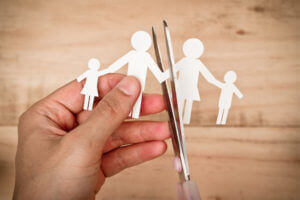This is a great article I found on Parents.com on how to discuss and ease the transition of divorce for children of various developmental stages:
Birth to 18 Months
Divorce represents a pivotal and often traumatic shift in a child’s world — and from his perspective, a loss of family. When told of the news, many children feel sad, angry, and anxious, and have a hard time grasping how their lives will change. The age at which a child’s parents divorce also has an impact on how he responds and what he understands about the new family structure. Here is a brief summary of what children comprehend at different ages and how you can help ease their transition.
During infancy, babies are able to feel tension in the home (and between their parents) but can’t understand the reasoning behind the conflict. If the tension continues, babies may become irritable and clingy, especially around new people, and have frequent emotional outbursts. They may also tend to regress or show signs of developmental delay.
How to ease the transition: Children this age require consistency and routine and are comforted by familiarity. Therefore, it’s helpful to maintain normal daily routines, particularly regarding sleep and meals, during and after the divorce. Provide your child with his favorite toys or security items, and spend extra time holding him and offering physical comfort. Rely on the help of friends and family, and be sure to get plenty of rest so you’ll be alert when your baby is awake.
18 Months to 3 Years
During the toddler years, a child’s main bond is with her parents, so any major disruption in her home life can be difficult for her to accept and comprehend. What’s more, kids this age are self-centered and may think they’ve caused their parents’ breakup. They may cry and want more attention than usual, regress and return to thumb sucking, resist toilet training, have a fear of being abandoned, or have trouble going to sleep or sleeping alone at night.
How to ease the transition: If possible, parents should work together to develop normal, predictable routines that their child can easily follow. It’s also important to spend quality time with your child and offer extra attention, and ask trusted friends and relatives to do the same. Discuss your child’s feelings (if she’s old enough to talk), read books together, and assure her that she’s not responsible for the breakup.
3 to 6 Years
Preschoolers don’t understand the whole notion of divorce and don’t want their parents to separate — no matter how tense the home environment. In fact, divorce is a particularly hard concept for these little “control freaks” to comprehend, because they feel as if they have no power to control the outcome.
Like toddlers, preschoolers believe they are ultimately responsible for their parents’ separation. They may experience uncertain feelings about the future, keep their anger trapped inside, have unpleasant thoughts or ideas, or be plagued by nightmares.
How to ease the transition: Parents should try to handle the divorce in an open, positive manner if possible, as a child this age will reflect his parents’ moods and attitudes. Preschoolers will need someone to talk to and a way to express their feelings. They may respond well to age-appropriate books about the topic. Kids this age also need to feel safe and secure and to know they will continue seeing their noncustodial parent (the one with whom they don’t live on a regular basis). Set up a regular visitation schedule, and make sure it’s adhered to consistently.
6 to 11 Years
If school-age kids have grown up in a nurturing environment, it will be only natural for them to have a fear of being abandoned during a divorce. Younger children — 5- to 8-year-olds, for instance — will not understand the concept of divorce and may feel as if their parents are divorcing them. They may worry about losing their father (if they’re living with their mom) and fantasize that their parents will get back together. In fact, they often believe they can “rescue” their parents’ marriage.
Kids from 8 to 11 may blame one parent for the separation and align themselves with the “good” parent against the “bad.” They may accuse their parents of being mean or selfish and express their anger in various ways: Boys may fight with classmates or lash out against the world, while girls may become anxious, withdrawn, or depressed. Children of either gender may experience upset stomachs or headaches due to stress, or may make up symptoms in order to stay home from school.
How to ease the transition: Elementary-school children can feel extreme loss and rejection during a divorce, but parents can rebuild their child’s sense of security and self-esteem. Start by having each parent spend quality time with the child, urging her to open up about her feelings. Reassure her that neither parent will abandon her, and reiterate that the divorce is not her fault. (Likewise, parents should not blame one another for the split, but explain that it was a mutual decision.) It’s also important to maintain a regular visitation schedule as kids thrive on predictability — particularly during times of turmoil.
Finally, since school, friendships, and extracurricular activities are of increasing importance to kids this age, encourage your child to get involved in events and pastimes she thoroughly enjoys. Help her rekindle her self-esteem, and encourage her to reach out to others and not withdraw from the world.
Sources: divorcesource.com; American Academy of Pediatrics; American Medical Association

